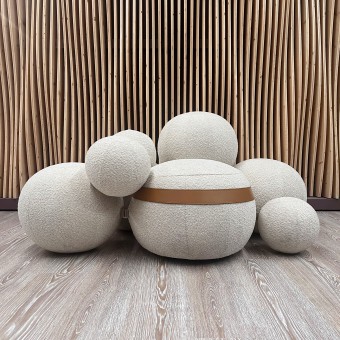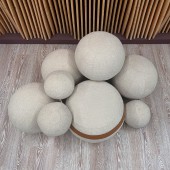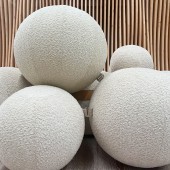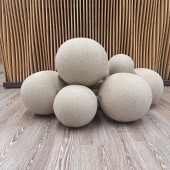
| THE AWARD |
| CATEGORIES |
| REGISTRATION |
| SUBMIT YOUR WORK |
| ENTRY INSTRUCTIONS |
| TERMS & CONDITIONS |
| PUBLICATIONS |
| DATES & FEES |
| METHODOLOGY |
| CONTACT |
| WINNERS |
| PRESS ROOM |
| GET INVOLVED |
| DESIGN PRIZE |
| DESIGN STORE |
| THE AWARD | JURY | CATEGORIES | REGISTRATION | PRESS | WINNERS | PUBLICATIONS | ENTRY INSTRUCTIONS |
Ariu Armchair by Vito D'Amato |
Home > Winners > Design #155624 >Interview |
 |
|
FS: What is the main principle, idea and inspiration behind your design?
VD: The main principle behind Ariu is ecodesign, emphasizing sustainability, adaptability, and user-centric functionality. The core idea is to create a versatile and modular sofa system that meets diverse needs while minimizing environmental impact. Ariu draws inspiration from the spherical shapes of water atoms, symbolizing the intrinsic relationship between humans and natural resources, particularly reflecting the water resource challenges faced in the Puglia region. This inspiration underscores the convergence of comfort, nature, and versatility in Ariu's design, aligning it with eco-friendly principles and innovative, user-focused solutions.
FS: What has been your main focus in designing this work? Especially what did you want to achieve?
VD: My main focus in designing Ariu was to create a multifunctional armchair that goes beyond traditional design, offering both fitness functionality and eco-friendliness. I wanted to achieve a versatile piece that adapts to various uses, such as lounging, exercising, and serving as individual poufs. By integrating these features, I aimed to challenge the conventional notion of an armchair and promote a more sustainable approach to furniture design. The use of eco-friendly materials and a disassemblable structure further underscores my commitment to sustainability, ensuring that Ariu is not only innovative and practical but also environmentally responsible.
FS: What are your future plans for this award winning design?
VD: For the future of Ariu, my plans include expanding its versatility and reach. I aim to develop additional modular components and accessories that can further enhance its functionality and adaptability, catering to even more diverse user needs and spaces. Exploring smart technology integrations, such as IoT connectivity, could provide users with advanced customization and control options. Additionally, I plan to collaborate with eco-friendly material innovators to continuously improve the sustainability aspect of Ariu, ensuring it remains at the forefront of environmentally responsible design. Expanding its availability in international markets is also a priority, making this award-winning design accessible to a global audience. Ultimately, my goal is to see Ariu evolve into a comprehensive solution for modern living, combining innovation, sustainability, and user-centric design to positively impact homes and lifestyles around the world.
FS: How long did it take you to design this particular concept?
VD: Designing Ariu took around one year to complete. This timeframe included developing the initial concept, refining the design, and implementing all the small details. The process involved extensive research, user feedback, multiple iterations, and prototyping to ensure the final product was both innovative and practical, meeting all the intended goals of versatility, sustainability, and user-centric functionality.
FS: Why did you design this particular concept? Was this design commissioned or did you decide to pursuit an inspiration?
VD: I designed Ariu as a response to a design competition, which provided the initial motivation and framework for the concept. The competition challenged designers to create innovative, multifunctional, and sustainable furniture. This opportunity allowed me to pursue my inspiration of creating an armchair that goes beyond traditional design, offering multiple functions like fitness and eco-friendly features. The goal was to develop a piece that adapts to modern living needs while promoting sustainability and user-centric design principles.
FS: Is your design being produced or used by another company, or do you plan to sell or lease the production rights or do you intent to produce your work yourself?
VD: Currently, Ariu is not being produced or used by other companies, but we are actively evaluating different proposals. Our goal is to find the best partnership or licensing arrangement to bring Ariu to market. We are open to selling or leasing the production rights to a company that shares our commitment to innovation and sustainability. Alternatively, we are also considering producing Ariu ourselves to maintain full control over its quality and environmental standards.
FS: What made you design this particular type of work?
VD: The motivation behind designing Ariu stemmed from a desire to create a multifunctional and sustainable piece of furniture that addresses the needs of modern living. Participating in a design competition provided the initial spark, challenging me to think beyond traditional armchair designs. I wanted to develop a concept that not only serves as a comfortable seating option but also offers additional functionality, such as fitness elements and modular versatility. Inspiration also came from the pressing need for eco-friendly products. By using sustainable materials and incorporating a disassemblable structure, I aimed to reduce environmental impact and promote responsible consumption. Ultimately, Ariu was designed to combine innovation, practicality, and sustainability in a way that enhances the user's experience and contributes positively to the environment.
FS: Where there any other designs and/or designers that helped the influence the design of your work?
VD: While I drew inspiration from various sources, including contemporary furniture design and sustainable architecture, Ariu's concept was primarily shaped by a synthesis of my own creative vision and user feedback. However, I'm continually inspired by the work of other designers who explore innovative approaches to furniture design, modular systems, and sustainable practices. Observing trends and advancements in the design industry also informs my creative process, pushing me to push boundaries and explore new possibilities.
FS: Who is the target customer for his design?
VD: The target customer for Ariu's design is anyone who values versatility, sustainability, and innovation in their furniture choices. Ariu caters to individuals living in diverse spaces, from small apartments to larger homes, who seek adaptable and eco-friendly seating solutions. Its modular design appeals to those who appreciate customizable furniture that can adapt to their changing needs and lifestyles. Additionally, Ariu's incorporation of smart technology features may attract tech-savvy consumers looking for modern conveniences in their furniture.
FS: What sets this design apart from other similar or resembling concepts?
VD: What sets Ariu apart from other similar concepts is its holistic approach to design, combining modularity, sustainability, innovation, and user-centric features in a seamless way. Here are some key aspects that differentiate Ariu: Modularity and Flexibility: Ariu's modular design allows for versatile configurations, catering to different spatial requirements and user preferences. Its adaptable nature sets it apart from traditional fixed-seating options. Sustainability: Ariu prioritizes eco-friendly materials and production processes, minimizing its environmental impact. Its commitment to sustainability distinguishes it from designs that prioritize aesthetics over ecological considerations. Innovation: Incorporating smart technology features such as built-in charging ports and adjustable cushions, Ariu offers modern functionalities that enhance user experience and convenience. User-Centric Design: Ariu's design is informed by user feedback and usability testing, ensuring that it meets the real needs and preferences of its users. Its focus on user-centricity sets it apart from designs that prioritize form over function. Aesthetic Appeal: While prioritizing functionality and sustainability, Ariu also boasts a sleek and contemporary aesthetic that appeals to design-conscious consumers. Its combination of form and function sets it apart as a versatile and stylish seating solution.
FS: How did you come up with the name for this design? What does it mean?
VD: The name "Ariu" was inspired by the element "Aria" encapsulated within the spherical balls of the design. "Aria" represents the essence of air or atmosphere, which resonates with the concept of the design as it relates to comfort, nature, and versatility. The name "Ariu" evokes a sense of lightness and harmony, reflecting the design's focus on creating a comfortable and sustainable seating experience.
FS: Which design tools did you use when you were working on this project?
VD: Throughout the development of the Ariu project, I utilized a variety of design tools to bring the concept to life and ensure its feasibility. These tools included: 1. 3D Studio Max for creating precise technical drawings and 3D models. 2. 3D modeling and rendering software like Blender to visualize and refine the design from different perspectives. 3. Prototyping tools such as 3D printers to produce physical models and prototypes for testing and evaluation. 4. Virtual reality (VR) technology using platforms like Unity for immersive visualization and simulation of the design in virtual environments. 5. Collaboration and project management software to facilitate communication and coordination among team members, clients, and stakeholders throughout the design process. These tools played a crucial role in translating ideas into tangible designs, iterating on concepts, and ultimately realizing the final product.
FS: What is the most unique aspect of your design?
VD: The most unique aspect of the Ariu design lies in its multifunctional modularity and sustainable construction. Unlike traditional armchairs, Ariu offers a versatile seating solution that can adapt to various needs and spaces. Its modular components enable users to reconfigure the sofa into different configurations, providing flexibility for different activities and preferences. Additionally, Ariu's sustainable design incorporates eco-friendly materials and a disassemblable structure, prioritizing environmental responsibility without compromising on functionality or aesthetics.
FS: Who did you collaborate with for this design? Did you work with people with technical / specialized skills?
VD: For the Ariu design project, collaboration was key to its success. Alongside CEO Vito D'Amato, Designer Michelangelo Bove, Project Manager Corrado Massimo, and Innovation Manager Cesaria Digregorio, we formed a multidisciplinary team with diverse technical and specialized skills. This collaboration allowed us to leverage expertise in areas such as design, project management, innovation, and sustainable practices, ensuring a comprehensive approach to the design process. Working closely together, we were able to bring the Ariu concept to life, incorporating innovative features and sustainable principles into its design.
FS: What is the role of technology in this particular design?
VD: Technology played a pivotal role in the development of the Ariu design. From ideation to execution, various technological tools and processes were employed to enhance its functionality, sustainability, and innovation. 1. **CAD Software**: Computer-Aided Design (CAD) software, such as Rhino and SolidWorks, facilitated the creation of detailed 3D models and technical drawings. This allowed for precise visualization and optimization of the design elements. 2. **Prototyping Technologies**: Advanced prototyping technologies, including 3D printing, enabled the rapid iteration and testing of design concepts. Prototypes were quickly produced to evaluate form, fit, and function, accelerating the design refinement process. 3. **Virtual Reality (VR)**: VR technology was utilized to simulate real-world environments and user interactions with the Ariu design. This immersive experience allowed for comprehensive testing and validation of ergonomic features and spatial arrangements. 4. **Sustainability Analysis Tools**: Tools for sustainability analysis and life cycle assessment were employed to evaluate the environmental impact of the design. This data-driven approach ensured that sustainable materials and manufacturing processes were prioritized throughout the design process. 5. **Smart Technology Integration**: Cutting-edge smart technologies, such as IoT sensors and integrated charging ports, were seamlessly integrated into the design. These features enhance the functionality and user experience of Ariu, aligning it with modern lifestyle preferences. Overall, technology served as a catalyst for innovation and efficiency in the development of Ariu, enabling the creation of a design that is both aesthetically compelling and environmentally responsible.
FS: Is your design influenced by data or analytical research in any way? What kind of research did you conduct for making this design?
VD: Yes, the design of Ariu was influenced by data-driven research and analytical insights, particularly in the areas of user behavior, sustainability, and material science. Several research methodologies were employed to inform the design process: User Research: Extensive user research was conducted to understand the needs, preferences, and pain points of potential users. Surveys, interviews, and user testing sessions provided valuable insights into how people interact with furniture in their homes and the features they value most. Market Analysis: A thorough analysis of market trends, competitor products, and emerging technologies was conducted to identify opportunities for innovation and differentiation. This research helped ensure that Ariu would meet the demands of a rapidly evolving market landscape. Sustainability Assessment: Sustainability was a core focus of the design, and comprehensive research was conducted to evaluate the environmental impact of various materials, manufacturing processes, and end-of-life disposal options. Life cycle assessment tools and sustainability standards were used to inform material selection and design decisions. Material Exploration: Research into advanced materials and manufacturing techniques was undertaken to identify sustainable and innovative solutions for Ariu. This involved studying the properties of different materials, such as recycled fabrics and eco-friendly plastics, and assessing their suitability for the design. Data Analysis: Quantitative data analysis was utilized to identify patterns and trends in user feedback, market research findings, and sustainability metrics. This data-driven approach helped prioritize design features and make informed decisions throughout the design process. By leveraging data and analytical research, Ariu was designed to not only meet the functional and aesthetic needs of users but also to minimize its environmental footprint and contribute to a more sustainable future.
FS: What are some of the challenges you faced during the design/realization of your concept?
VD: During the design and realization of Ariu, we faced various challenges, including ensuring structural integrity in a modular system, selecting sustainable materials, integrating smart technology, optimizing for production efficiency, addressing user comfort and ergonomics, and navigating regulatory compliance. These obstacles demanded innovative solutions, collaborative problem-solving, and a commitment to excellence in design and engineering.
FS: How did you decide to submit your design to an international design competition?
VD: We decided to submit Ariu to an international design competition as a strategic way to gain recognition, showcase our innovative approach, and connect with a broader audience in the design community. We saw it as an opportunity to validate our work, receive feedback from experts, and potentially open doors to collaboration or partnership opportunities. Additionally, participating in prestigious competitions helps elevate the profile of our brand and reinforces our commitment to excellence in design.
FS: What did you learn or how did you improve yourself during the designing of this work?
VD: During the design process of Ariu, I learned the importance of collaboration and interdisciplinary teamwork. Working closely with experts in various fields, such as materials science, engineering, and sustainability, allowed me to gain new insights and perspectives. This collaborative approach helped me push the boundaries of my own expertise and consider factors beyond aesthetics, such as functionality, ergonomics, and environmental impact. Additionally, I honed my skills in prototyping and testing, realizing the value of iterative design and user feedback in refining and improving the final product. Overall, the experience of designing Ariu challenged me to think holistically and innovatively, ultimately leading to personal growth and professional development.
FS: Any other things you would like to cover that have not been covered in these questions?
VD: No, everything seems to be covered. If you have any more questions or need further clarification on anything, feel free to ask!
FS: Thank you for providing us with this opportunity to interview you.
A' Design Award and Competitions grants rights to press members and bloggers to use parts of this interview. This interview is provided as it is; DesignPRWire and A' Design Award and Competitions cannot be held responsible for the answers given by participating designers.
| SOCIAL |
| + Add to Likes / Favorites | Send to My Email | Comment | View Press-Release |





